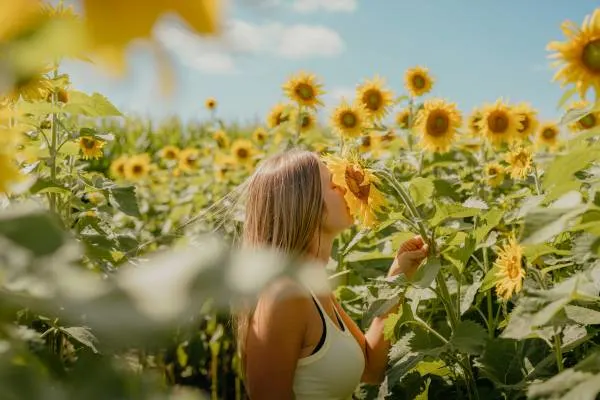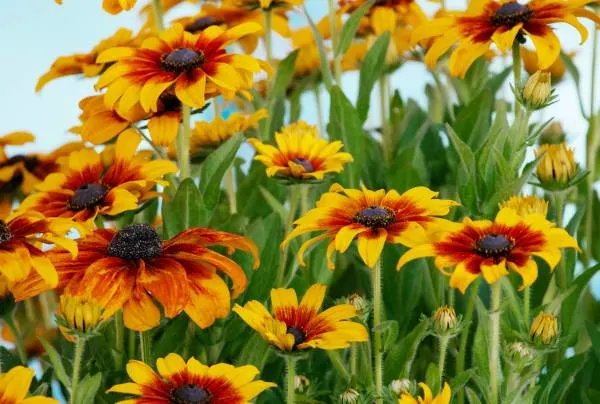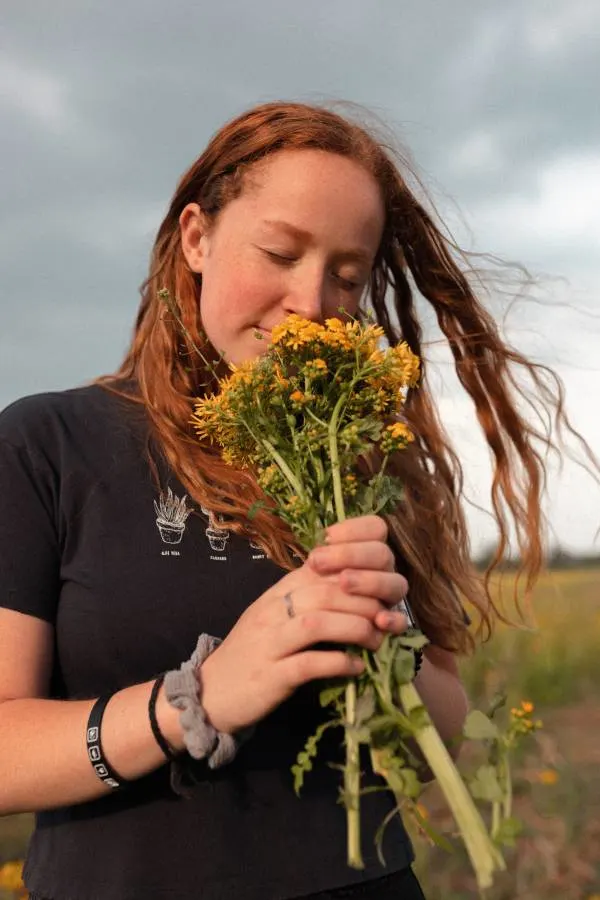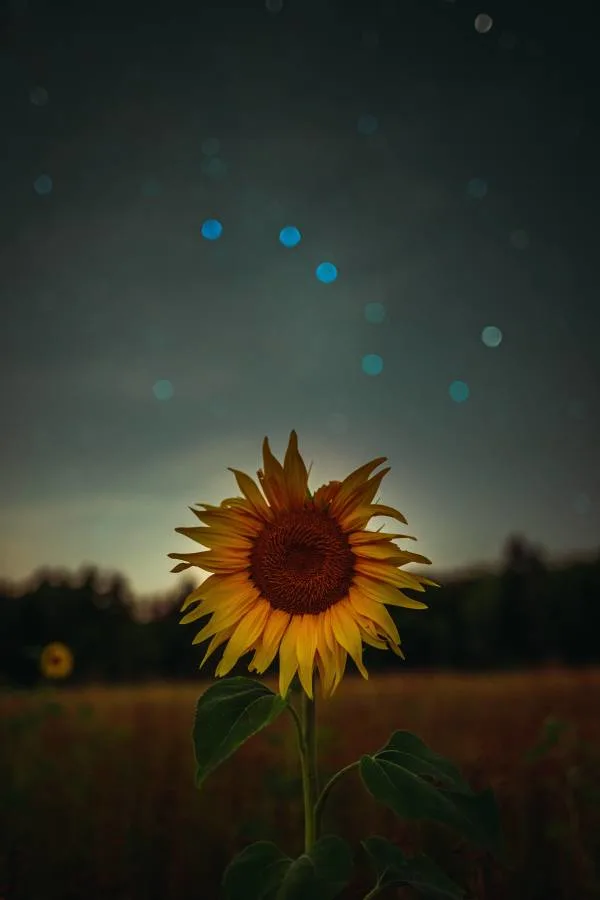Sunflower scent is often described as slightly sweet, reminiscent of a delicate blend of honey and warm summer days.
This gentle sweetness, however, is not overpowering but rather a nuanced whisper that lingers in the air, inviting you to lean in closer, to surrender to the enchantment that awaits.
It is important to note that not all sunflowers possess a strong scent. While some varieties may boast a more pronounced fragrance, others exhibit a very light smell, barely detectable to the human nose.
Welcome to the fragrant realm of sunflowers, where the golden petals hold secrets beyond visual beauty. As we embark on a sensory exploration, we delve into an interesting question: “What do sunflowers smell like?”
Prepare to be transported to fields of vibrant blooms, so read the article till the very end to know the answer to this enchanting question.
Let’s begin!

Here’s What a Sunflower Smells Like!
Sunflowers typically have a very mild scent.
Unlike some other flowers with strong, overpowering scents, sunflowers smell earthy, with hints of greenery and freshness. Some people may detect a delicate sweetness in the scent.
It’s important to note that not all sunflowers have a noticeable fragrance.
Some varieties may have a slightly stronger scent, while others may have little to no detectable smell.
Additionally, several environmental factors can influence how a sunflower smells.
Sunflowers Do Not Have a Floral Smell
Sunflowers, in general, do not have a characteristic floral fragrance.
Instead, they are known for being almost entirely scentless or having an extremely mild smell. The lack of a strong flower scent is one of the distinctive characteristics of sunflowers.
While their visual appeal is truly captivating, they do not release the same kind of fragrance as some other flowers like roses or lilies.
The primary focus of sunflowers’ allure lies in their vibrant colors, striking appearance, and their association with the sun and warm summer days.
Sunflowers Give off a Resinous and Vegetal Smell
While sunflowers may lack the traditional floral fragrance, they possess a unique and intriguing smell that can be described as vegetal and resinous.
Yes, sunflowers smell vegetal! This distinctive scent sets them apart from other flowers, adding another layer of enchantment to their already captivating nature.
When you encounter a sunflower up close, particularly around its center where the sunflower seeds develop, you may notice a gentle earthy aroma. It carries top notes reminiscent of fresh greenery, similar to the scent of freshly cut grass or young plant shoots.
This characteristic scent reflects the sunflower’s connection to nature and its origins as a native plant of the Americas.
In addition to its vegetal undertones, sunflowers also emit a resinous scent, especially when you rub sunflower stems or sunflower leaves between your fingers. This resinous scent is akin to the fragrance released by certain tree resins, like pine or fir, creating a natural and earthy ambiance.
Related Article: Why Are My Sunflowers Drooping & How Should You Fix It? (growgardener.com)

5 Important Affecting the Sunflower Scent!
The smell of sunflowers, or the lack thereof, can be influenced by several other factors.
While sunflowers are not typically known for having a strong fragrance, there are certain elements that can impact the intensity or presence of their scent.
Let’s explore some of these factors:
1. Variety, Species, and Genetics
Different varieties and species of sunflowers may exhibit variations in their scent profiles.
Some sunflower varieties may possess a more pronounced fragrance, while others may have little to no detectable scent. Within the plant’s DNA, specific genes govern the production of unique fragrance in sunflowers, dictating both the variety and quantity of fragrance compounds that the plant will synthesize.
Moreover, the interplay between genetic variations and environmental factors can intricately shape the scent of the sunflower. Alterations in temperature or light conditions can influence the activation of fragrance-related genes, leading to variations in the flower’s scent.

2. Maturity and Growth Stage
The scent of a sunflower can vary depending on its maturity and growth stage.
In the early stages of growth, when the sunflower is still a young bud or in the process of unfurling its petals, the scent may be either absent or extremely elusive. As the flowerhead continues to develop and reaches its full bloom, the concentration of fragrant compounds tends to increase. This is the stage when the scent of the sunflower is worth noting.
The peak scent production typically occurs when the sunflower is in its prime, displaying a stunning array of golden petals around the dark, prominent center.
At this stage, the flower is actively receiving sunlight and converting it into energy through photosynthesis. This fuels various metabolic processes, including the synthesis and emission of volatile compounds responsible for the perfume.
However, as the sunflower approaches the end of its life cycle, its scent may wane.

3. Environmental Conditions
Environmental factors play a role in the expression of a sunflower’s scent.
Sunlight, temperature, humidity, and soil conditions can all influence the production and release of volatile compounds responsible for the aroma.
A sunflower growing in optimal conditions, receiving ample sunlight and appropriate moisture, may have a more distinct scent compared to those growing in less favorable environments.
4. Time of Day
The time of day can impact the intensity of a sunflower’s scent.
It is believed that the fragrance of sunflowers is more pronounced during the morning hours as well as the evening hours. This is because, at these two times of the day, the temperatures are low hence lowering the rate of evaporation.
This keeps the scent lingering in the air.
Other warm, sunlit hours of the day when flowers are actively receiving sunlight make the temperature high, causing the scent to evaporate.

5. Individual Sensitivity
The perception of scent can vary from person to person. Some individuals may have a heightened sense of smell and be more attuned to the subtle fragrances of sunflowers, while others may not detect any noticeable scent.
Factors such as individual olfactory sensitivity and personal preferences can influence how one perceives the fragrance of sunflowers.
That’s all!
Let’s head toward the conclusion.
Conclusion!
Sunflowers are celebrated for their breathtaking visual beauty and their association with the sun; their fragrance often remains a subtle enigma.
Unlike traditional floral scents, the aroma of sunflowers leans towards the vegetal and resinous, evoking the essence of nature’s resilience and vitality. Their delicate fragrance, when present, can transport us to sunlit meadows and flourishing gardens, breathing life into the surrounding air with gentle whispers of greenery and warmth.
Here it must be noted that factors such as variety, maturity, environmental conditions, and genetic variations all contribute to the intricate dance of scents within the sunflower.
As the flower progresses through its life cycle, from a young bud to full bloom, the production and release of fragrance compounds shift, creating a dynamic olfactory experience.
With all that said, it’s time to wrap up the talk!
I hope you liked today’s article. If so, don’t forget to share it with your family and friends.
Regards!
